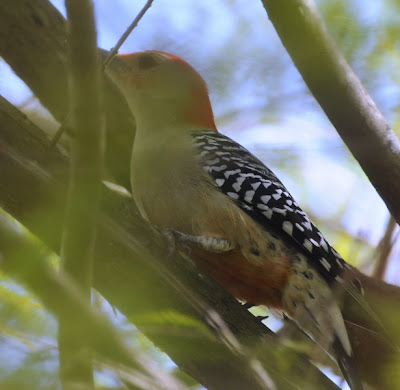Green Cay was swarming with dragonflies, most of them zipping past at frustrating speed. Here are two pondhawks: a Pin-tailed Pondhawk (Erythemis plebeja) and an Eastern Pondhawk (Erythemis simplicicollis).
This was a new species for me, a female Four-spotted Pennant (Brachymesia hervida), the only North American dragonfly with entirely white pterostigmas according to Sidney Dunkle's Dragonflies Through Binoculars (Oxford University Press, 2000). The pterostigmas are the blood-filled blisters near the tips of the wings (looking rather like grains of rice on this individual). They are used, according to Dunkle, in signalling mates or rivals.
My Asian readers may find this photograph strangely familiar. It is a female Scarlet Skimmer (Crocothemis servilia), a dragonfly that properly belongs on the far side of the Pacific, where it ranges from Asia to Australia (in 2010 I photographed males in Malaysia and China). It first showed up in Miami in 1975, and now ranges from Orlando to the Keys (as well as Cuba and Hawaii).
More familiar to me were these male Eastern Pondhawks (Erythemis simplicicollis).
The commonest dragonfly at Green Cay was the little Blue Dasher (Pachydiplax longipennis). I was able to take a series of photos of individuals ranging from females (or young males) to fully mature male adults. These are females or young males - nothing particularly blue about them (though they are rather dashing).
And here is an adult male. Not only is he now nicely blue on the abdomen and rear part of the thorax, but his eyes have turned jade green.
Common Gallinules (Gallinula galeata) are, as their name implies, common at Green Cay. In case you were wondering why this bird isn't called Gallinula chloropus, that's because we now realize (based on vocalizations and other evidence) that this is a separate species from the true chloropus, the Common Moorhen of the Old World.
Pied-billed Grebes (Podilymbus podiceps) are common too. This bird is in non-breeding plumage, with only a hint of the dark crossbar on the bill that gives the species its name.
Limpkins (Aramus guarauna), though not rare, are far shyer and harder to come by at Green Cay than the gallinules and grebes. They are commoner in the natural sawgrass marshes to the west, where they are more likely to find the Apple Snails (Pomacea paludosa) that are their favorite food. The Limpkin is a peculiar bird, the only member of its family; its closest relatives, according to DNA evidence, are the cranes (Gruidae).
Florida Red-bellied Turtles (Pseudemys nelsoni) are abundant at Green Cay, where we often saw them basking on logs or debris. Many of them, like these two, carry a coating of algae on their shells.
Daggerwing is a very different sort of place - a hardwood hammock (a slighty elevated patch of land that can support trees) isolated in a suburban development. It is named for one of its more striking butterflies, the Rusty Daggerwing (Marpesia petreus), though we did not see any on this visit.
When I first visited here, shortly after the center opened in 1996, the hammock was dominated by a splendid growth of large strangler figs. The figs were subsequently destroyed by a hurricane, and only now is the tree cover - the result of regrowth and plantings - starting to get back to full size. This s the view from the overlook tower at one end of the short boardwalk.
The figs, of course, have not come back yet as stranglers require mature trees of other species to get a purchase ad grow. Among the trees now growing at Dagerwing is Baldcypress (Taxodium distichum), though of course it will be a long time before they reach their full height (the largest known specimen is over 44 metres tall).
Palm Warblers (Setophaga palmarum) are the commonest wintering warblers everywhere in South Florida, and there were plenty of them at both Green Cay and Daggerwing.
The Red-bellied Woodpecker (Melanerpes carolinus) is, to my mind, one of the handsomest of the North American woodpeckers. At our home in southern Ontario we are at the extreme northern fringe of its range. It is a rare sight there, so I am always glad to see it in Florida where it are abundant and widespread. This is a male at Daggerwing.
Finally, a less than perfect shot, but of a bird I don't see too often (though they are common enough in both Florida and Ontario: a Merlin (Falco columbarius) at Daggerwing, perched atop a broken spar.






















No comments:
Post a Comment